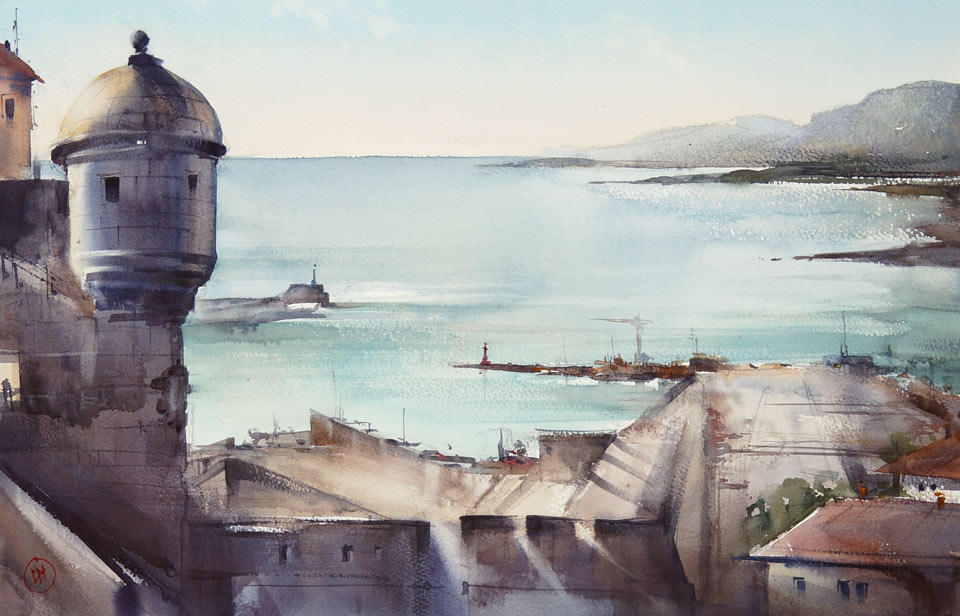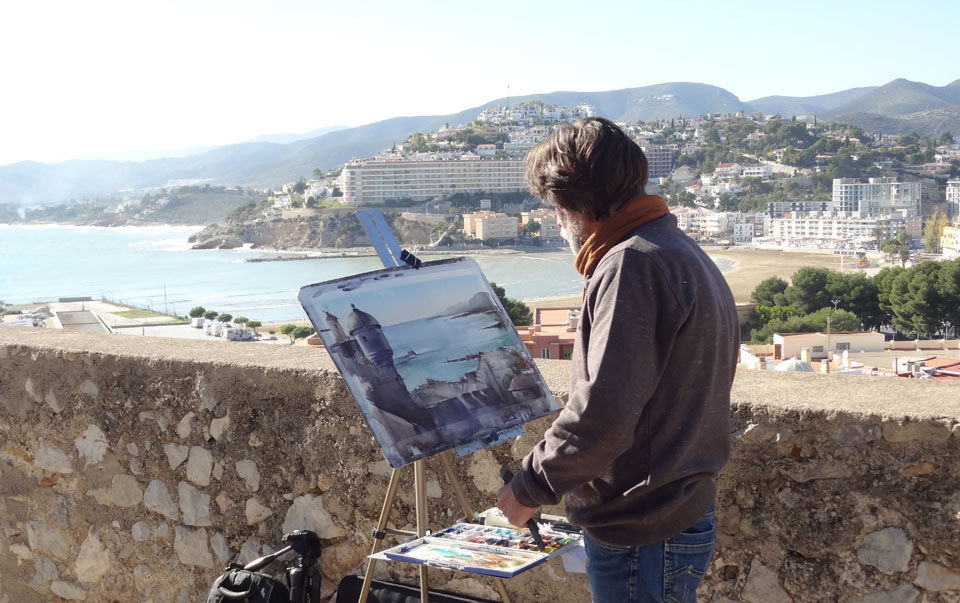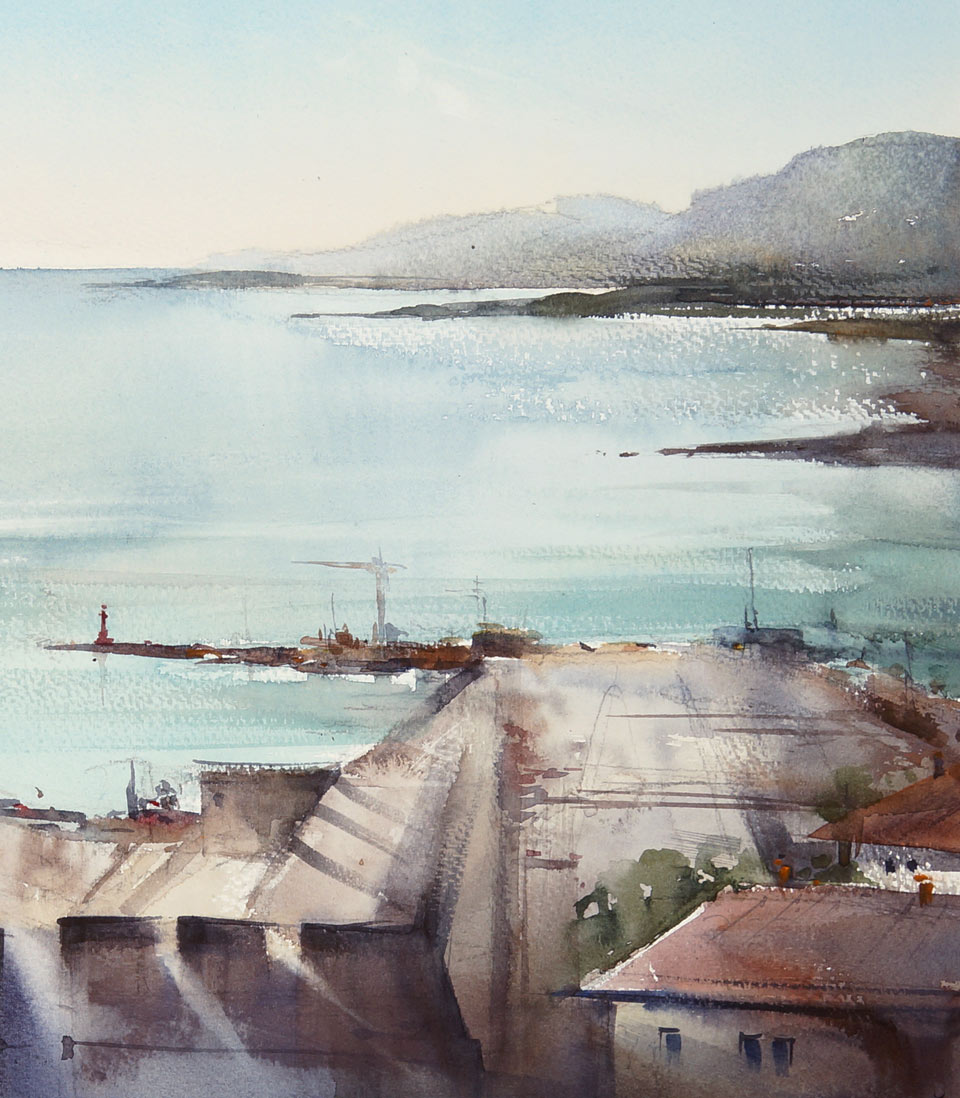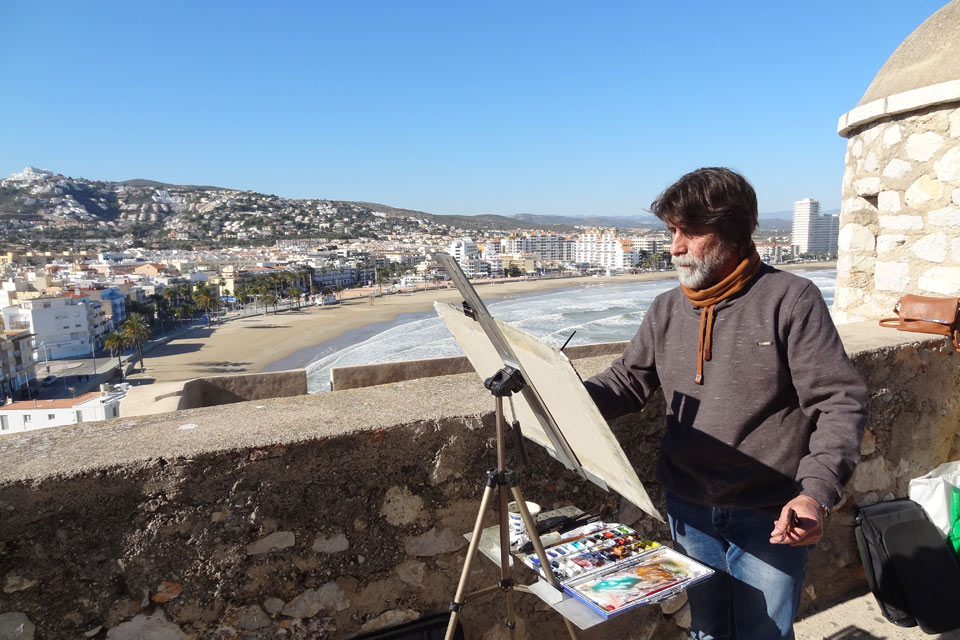A self-study, self-paced course where you can learn how to paint in watercolor by watching video lessons and doing assignments
$297 USD
ENROLL NOWA self-study, self-paced course where you can learn how to paint in watercolor by watching video lessons and doing assignments
$297 USD
ENROLL NOWOne-to-one, unlimited and custom-tailored to your skills and needs Personal Tutoring by the Watercolor Academy teachers
$997 USD
ENROLL NOWBy Ilya Ibryaev
It is a wonderful morning, and we are in a small old Spanish town, next to the castle that stands on the Mediterranean Sea coast. Here is the watercolor artwork I will achieve by the end of this lesson.

I will be painting on location, standing on the rock on which the castle is built. The view from here contains some incredible scenery. The morning sky is clear and cloudless, and the Sun is in front of me. As we are looking down on the town from above, it compositionally makes sense to place the horizon of this artwork in the top half. When planning to paint outdoors, it is important to find a place in a shadow, without direct sunlight, otherwise the bright light will make it hard to see real colors of paints.
Here is the beautiful view seen from this point; we can see the castle walls, the sea and the hills.

I am making a rough sketch in graphite pencil on watercolor paper. The key feature of this view is a round bartizan, which is a small tower projecting from the castle wall. The approximate sketch is done, and I can now continue painting in color. Since the sunlight is warm in color, I use a mix of yellow ochre light, Cadmium red and Cadmium orange, and apply it wet-on-dry. I use the round mop brush for this purpose. A little bit of Cadmium red can be added wet-into-wet, to warm up the color. The cold blue color is also painted wet-into-wet, with wide brushstrokes. The board is rotated upside down for the wet wash to flow and intermix the pigments.
With a damp clean brush, I wipe off wet paint from paper, to indicate some small white clouds. Although the sky is very clear in real life, I add some clouds to make it a bit more interesting. The mountains on the background are painted wet-into-wet. Their color is mixed from Ultramarine and Cadmium orange. The hills closer to us have darker tonal values. Also, there is some greenery on the hill. A warmer mix of Sap green and Cadmium orange is added to the part of the background that is closer to us. This creates an illusion of aerial perspective, where the hills closer to us are warmer and greener than those that are further away. When you need to decide on the tonal values, there is one trick you can use: if you place a black paintbrush handle next to the artwork, its color can serve as a measuring stick, for you to decide how deep the darkest tone of the artwork should be.

I will now paint the sea. Its blue color is mixed from Ultramarine, Veridian and Cadmium orange; this is the mix for the top half of the sea. I apply the paint with a flat wide brush. You may notice that I leave accidental white gaps; these random gaps are highlights on the sea water. These white spots are preserved because I apply very light pressure with a semi-dry brush. To deepen up the tone of the sea I can now paint wet-into-wet, adding more pigment with a smaller brush. One again, I use a bigger brush to continue the first wash. A bit more Viridian is added into the mix, to make the sea color slightly greener. Such a change in color also helps me to create an illusion of aerial perspective, because warmer colors appear visually closer to a viewer.
I am adding Cadmium orange and yellow ochre light into the blue mix that I am using for the sea color, in order to warm it up. The Sun is in front of us, and the bartizan and the castle walls are lit from behind, which produces a dark silhouette on the light background. For the gray color of the stones which make up the castle, I am using a mix of Ultramarine and Cadmium orange. These two pigments, depending on their quantity in the mix, can create a very wide range of color temperature, from cold blue to warm yellow. Also, because blue is a dark color, the mix can range from very dark values to very light tints. I am no longer in the shadow, and the sunlight makes it more difficult to paint outdoors. Nevertheless, I am half-way through this artwork, and I will complete it soon.

I am standing on the alure, which is the walkaway along the top of the wall – this high place allows me to see fantastic views over the seaport and the castle. The palette is brightly lit by the Sun, meaning that it is not easy to see true colors. This is where previous experience becomes very handy, so that I can mix the colors I know, and test them on paper to see if the color is right. By the way, if you are wondering what the location is, we are painting Peniscola Castle, in the Community of Valenica in Spain. This place has a long history which goes back more than 2000 years, dating back to Roman times, although the castle we see today was built and renovated later on. In the early 15th Century, this castle served as the residence of the Roman Pope, Benedict XIII. He was also known as 'El Papa Luna', and was considered at the time to be an antipope.
Let's return to the painting. I am building up tonal values to achieve a greater contrast between the light background and the foreground. To break up the dark wall, I am using a natural sea sponge to apply a washing out technique, in order to show rays of light beaming through the embrasure, which is an opening in the wall through which the defenders would shoot arrows through. To increase the light and shadow contrast, I paint the wall even darker. There are a few more details left to be added. The wall that protects the harbor is painted with the same mix of Ultramarine and Cadmium orange. I also add a few more details to the background, painting the shoreline in darker tones. The red roofs of buildings are added to the middle ground; the color is mixed from Cadmium red and Ultramarine. I use the thin round brush to add small details, such as lampposts and port equipment. Green trees are added behind red roof buildings; their green color is obtained by mixing Ultramarine with Cadmium yellow. The artwork is gradually taking shape. It is not my creative task to meticulously capture every detail; instead, I am creating an impressionistic illusion of this place. With a small flat synthetic brush, I can add some sharper and smaller details, like windows and aerials on the roofs. I use the wider, flat brush, to cover bigger areas and apply additional glazing washes. The painting sequence can go in cycles: first making white washes, then adding smaller details, and afterwards, uniting all small areas once again, by applying glazing layers on top.
The Sun is bright and the sky is clear, so we can see far away and comprehend the aerial perspective, where the distant hills are very light and pale. The hills that are closer to us are darker and have more saturated colors. The light dark contrast, or the contrast of values, is very sharp. I used light colors to depict the sky and the sea, and dark values for the foreground. As the Sun is getting higher, colors and tones are changing. This doesn't mean, however, that I have to constantly amend the artwork; this is a snapshot of a moment in time...
A self-study, self-paced course where you can learn how to paint in watercolor by watching video lessons and doing assignments
One-time payment - Lifetime membership
$297 USD
One-to-one, unlimited and custom-tailored to your skills and needs Personal Tutoring by the Watercolor Academy teachers
One-time payment - Lifetime membership
$997 USD